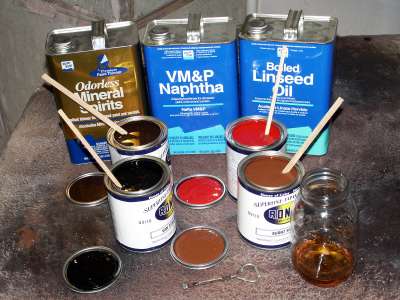You can buy per
made glazing compounds but I find it more convenient and practical
to make my own. By adjusting the amount of Boiled Linseed Oil and
different solvents like Odorless Paint Thinner, Naphtha (VM&P) or
Turpentine with the Japan and/or Oil Colors I can customize not
only the color but most importantly the set-up and working time
(drying time) of the glaze mixture. You will need different set-up
and working time for glazing if it is a hot and humid summer day
then you do on a cold dry day in February! Also you need to adjust
the working time for the size of the object(s) and whether you are
going to spray on the glaze of wipe it on with a rag.
Example, It only take a few minutes to brush out a glaze on a small
3 legged pedestal table. So you can use a fast drying solvent like
Naphtha and spray it on. This door project has a very large
surface area to work at one time, I will use a rag to apply the
glaze because it will give me a stronger fill or coverage in the
grain, corners and crevices. I want as much grain contrast as I can
get to make the plastic look more like wood. (Spraying on a glaze
gives a more even color with out build in the crevices and corners.
You typically work the glaze into the corners when sprayed and work
it out of the corners when wiped on.) Because it is a very hot July
day I'm using Odorless Paint Thinner (because it dries slower than
Turpentine and I don't like the Turpentine's strong smell) and
extra Boiled Linseed Oil to slow down the glaze's drying time so I
have a much longer working time that will be required for the large
surface areas of this project.
The "set-up time" is the amount of time you have to evenly spread
(brush) out the glaze over the surface and work out the brush
marks. This set-up drying time is mostly controlled by the solvent
you choose. The "working time" is the amount of time you have to
"strike out" and high light the grain pattern before the glaze is
completely dry. This working time is mostly controlled by the
amount of Boiled Linseed Oil you use.
I don't have or use a formula to mix a glaze. I just guest-a-mate
the amounts needed by experience. I work a section (drawer front,
side panel, leg, etc.) of the project and if the glaze is setting
up and/or working time to fast or to slow, I adjust by adding the
appropriate chemical(s).
|
